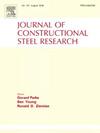Stress intensity factor of double fatigue cracks at the rib-to-diaphragm connection in orthotropic steel decks
IF 4
2区 工程技术
Q1 CONSTRUCTION & BUILDING TECHNOLOGY
引用次数: 0
Abstract
This study investigates the interaction behavior of double fatigue cracks in rib-to-diaphragm connections of orthotropic steel decks (OSDs) through numerical simulations. Finite element models were developed using ABAQUS and FRANC3D software to analyze Mode I stress intensity factors (SIFs) under vehicle loading conditions. The numerical findings demonstrate that when vehicle loads approach both mid-diaphragm sides, the SIF of initial cracks increases due to interaction with artificial penetrating cracks. The study introduces an interaction factor (λ) to quantify this crack interference (amplification or reduction) effect. Parametric analyses reveal that interaction effects intensify with decreasing diaphragm thickness and increasing crack length. At diaphragm cutouts, crack interaction becomes more significant as initial crack shape ratios approach unity, while at weld locations, this effect diminishes with similar shape ratios. The research further develops a hybrid computational approach combining backpropagation neural networks with particle swarm optimization (BP-PSO) to predict multi-crack SIF interaction factors. Validation shows the model achieves satisfactory prediction accuracy, offering practical value for fatigue crack assessment and repair strategies in OSD bridge connections. The proposed methodology and findings provide engineers with quantitative tools for evaluating crack interaction effects in actual orthotropic deck applications.
正交各向异性钢甲板肋-隔板连接双疲劳裂纹的应力强度因子
通过数值模拟研究了正交各向异性钢甲板肋-隔板连接双疲劳裂纹的相互作用行为。利用ABAQUS和FRANC3D软件建立有限元模型,分析车辆加载条件下I型应力强度因子(SIFs)。数值计算结果表明,当车辆荷载同时靠近隔膜中部两侧时,由于人工穿透裂纹的相互作用,初始裂纹的SIF增大。该研究引入了一个相互作用因子(λ)来量化这种裂纹干涉(放大或减小)效应。参数分析表明,随着膜片厚度的减小和裂纹长度的增加,相互作用的影响增强。在膜片切口处,当初始裂纹形状比趋于一致时,裂纹相互作用变得更加显著,而在焊缝位置,当初始裂纹形状比相似时,这种影响减弱。研究进一步发展了一种结合反向传播神经网络和粒子群优化(BP-PSO)的混合计算方法来预测多裂纹SIF相互作用因子。验证表明,该模型具有较好的预测精度,为OSD桥梁连接疲劳裂纹评估和修复策略提供了实用价值。提出的方法和发现为工程师提供了定量的工具来评估实际正交各向异性甲板应用中的裂缝相互作用效应。
本文章由计算机程序翻译,如有差异,请以英文原文为准。
求助全文
约1分钟内获得全文
求助全文
来源期刊

Journal of Constructional Steel Research
工程技术-工程:土木
CiteScore
7.90
自引率
19.50%
发文量
550
审稿时长
46 days
期刊介绍:
The Journal of Constructional Steel Research provides an international forum for the presentation and discussion of the latest developments in structural steel research and their applications. It is aimed not only at researchers but also at those likely to be most affected by research results, i.e. designers and fabricators. Original papers of a high standard dealing with all aspects of steel research including theoretical and experimental research on elements, assemblages, connection and material properties are considered for publication.
 求助内容:
求助内容: 应助结果提醒方式:
应助结果提醒方式:


